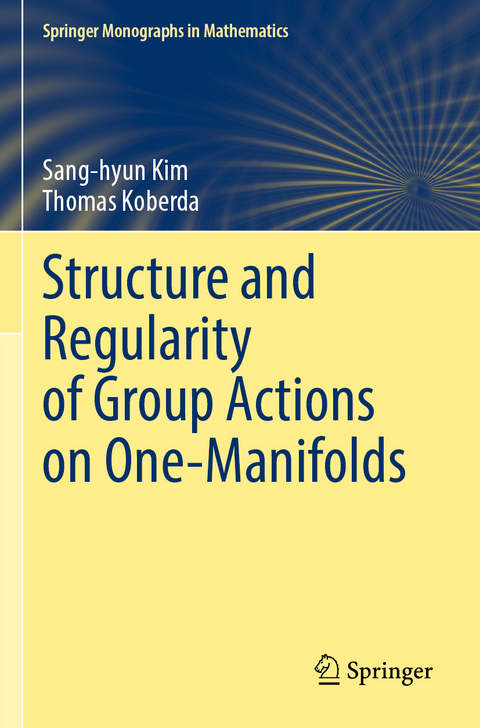
Structure and Regularity of Group Actions on One-Manifolds
Springer International Publishing (Verlag)
978-3-030-89008-7 (ISBN)
This book presents the theory of optimal and critical regularities of groups of diffeomorphisms, from the classical work of Denjoy and Herman, up through recent advances. Beginning with an investigation of regularity phenomena for single diffeomorphisms, the book goes on to describes a circle of ideas surrounding Filipkiewicz's Theorem, which recovers the smooth structure of a manifold from its full diffeomorphism group. Topics covered include the simplicity of homeomorphism groups, differentiability of continuous Lie group actions, smooth conjugation of diffeomorphism groups, and the reconstruction of spaces from group actions. Various classical and modern tools are developed for controlling the dynamics of general finitely generated group actions on one-dimensional manifolds, subject to regularity bounds, including material on Thompson's group F, nilpotent groups, right-angled Artin groups, chain groups, finitely generated groups with prescribed critical regularities, and applications to foliation theory and the study of mapping class groups.
The book will be of interest to researchers in geometric group theory.
Sang-hyun Kim is a faculty member of the Korea Institute for Advanced Study. He earned his PhD at Yale University in 2007, under the supervision of Andrew J. Casson. Previously, he has worked at the University of Texas at Austin, Tufts University, KAIST and Seoul National University. He received the Sang-San Prize for Young Mathematicians in 2012, and the Korea Scientist and Engineer of the Month Award in 2020.Thomas Koberda is an Associate Professor at the University of Virginia. He received his PhD in 2012 from Harvard University, under the direction of Curtis T. McMullen. He held an NSF postdoctoral fellowship and was a Gibbs Assistant Professor at Yale University from 2012 to 2015, before joining the faculty at the University of Virginia in 2015, where he was appointed Associate Professor in 2019. In 2017, he was named an Alfred P. Sloan Foundation Research Fellow and was awarded the Kamil Duszenko Prize for his work in geometric group theory.
1. Introduction.- 2. Denjoy's Theorem and Exceptional Diffeomorphisms of the Circle.- 3. Full Diffeomorphism Groups Determine the Diffeomorphism Class of a Manifold.- 4. The C1 and C2 Theory of Diffeomorphism Groups.- 5. Chain Groups.- 6. The Slow Progress Lemma.- 7. Algebraic Obstructions for General Regularities.- 8. Applications.- A. Concave Moduli of Continuity.- B. Orderability and Hölder's Theorem.- C. The Thurston Stability Theorem.- Index.
"Great care has been taken to both make the book essentially self-contained, and to motivate the core questions and results by putting them in an engaging and broad context. This makes the book an interesting resource both for researchers interested in a streamlined approach to modern results on critical regularity, and students (or instructors) wanting to learn (or teach) about more classical results on groups of diffeomorphisms in dimension 1." (Sebastian Hensel, zbMATH 1486.57001, 2022)
"It should be suitable for most researchers and graduate students with an interest in learning about differentiable group actions. The authors give complete proofs of all of the main results ... ." (Michael Hull, MAA Reviews, June 20, 2022)| Erscheinungsdatum | 23.11.2022 |
|---|---|
| Reihe/Serie | Springer Monographs in Mathematics |
| Zusatzinfo | XIV, 323 p. 7 illus., 4 illus. in color. |
| Verlagsort | Cham |
| Sprache | englisch |
| Maße | 155 x 235 mm |
| Gewicht | 517 g |
| Themenwelt | Mathematik / Informatik ► Mathematik ► Algebra |
| Mathematik / Informatik ► Mathematik ► Geometrie / Topologie | |
| Schlagworte | critical regularity • Denjoy theory • diffeomorphism • one-manifold • orderable group |
| ISBN-10 | 3-030-89008-2 / 3030890082 |
| ISBN-13 | 978-3-030-89008-7 / 9783030890087 |
| Zustand | Neuware |
| Informationen gemäß Produktsicherheitsverordnung (GPSR) | |
| Haben Sie eine Frage zum Produkt? |
aus dem Bereich


